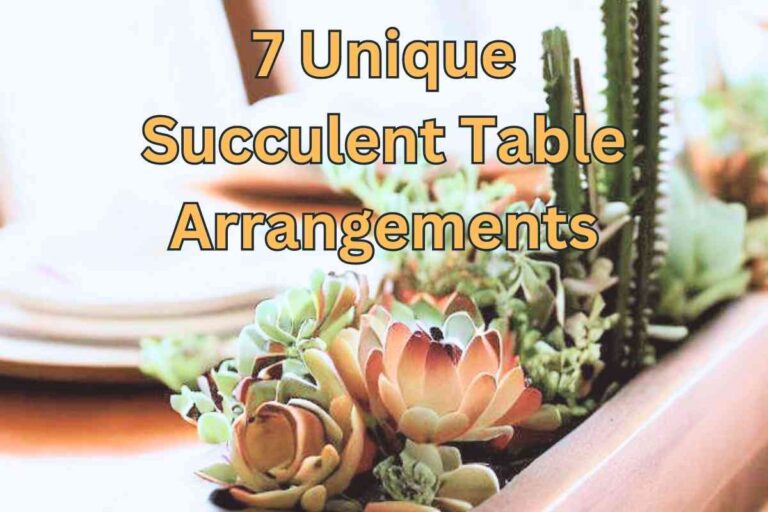Succulent Rock Garden Ideas for Any Garden
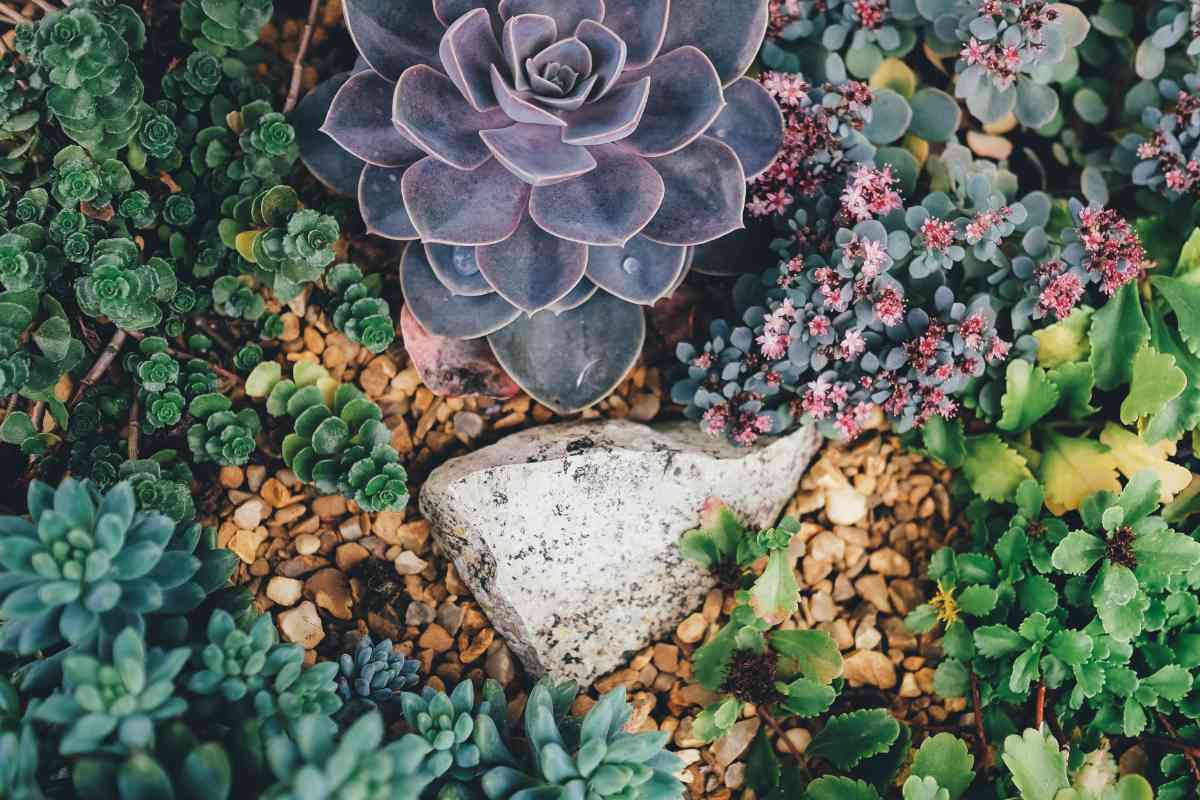
Wait… every succulent isn’t a rock garden? Seriously, there are some great succulent designs that DON’T involve rocks, but in my personal opinion, the best succulent designs use rocks.
After all, succulents rub shoulders with rocks in the wild, so why shouldn’t they in your garden?
These 6 Succulent Rock Garden Ideas for Any Garden are sure to inspire your succulent and rock gardening creativity.
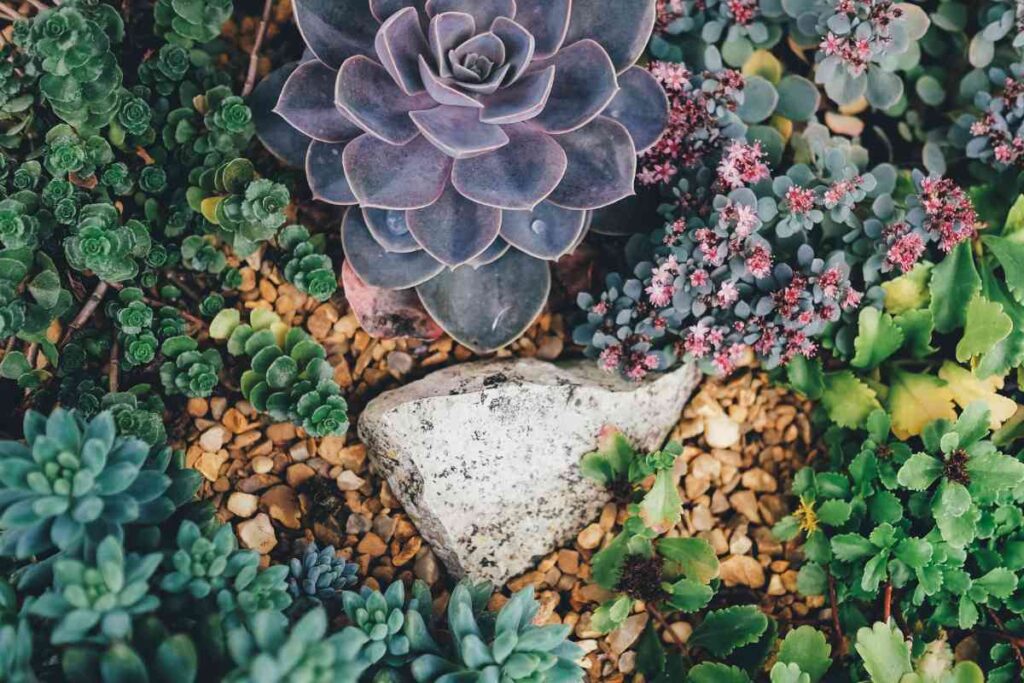
Love decorating and gardening with succulents? When you’re done reading this article, check out this one which is full of succulent design and arrangements tips and ideas.
This article covers everything you need to know about caring for succulents, so if you’re unsure about ANY aspect of their care, check it out.
Summary
- Mountainous Succulent Rock Garden:
- Select a spot with sunlight and natural slope for a mountainous effect.
- Collect rocks of different sizes and arrange them to mimic desired topography.
- Choose proportional succulents and place strategically around the rocks.
- Vertical Succulent Rock Garden:
- Build a self-standing wall with soil pockets or attach wire mesh.
- Use flat rocks to create planting pockets for succulents.
- Fill pockets with well-draining soil mix and plant succulents accordingly.
- Miniature Succulent Rock Garden:
- Collect rocks of the same type with varying shapes and sizes.
- Arrange rocks to create a natural-looking terrain.
- Use compact succulents and create planting pockets between rocks.
- Desert Valley Succulent Rock Garden:
- Plan a meandering path with stepping stones.
- Use a variety of rocks in different sizes, shapes, and colors.
- Select diverse succulents and fill gaps with smaller rocks or gravel.
- Dry Stream Succulent Rock Garden:
- Outline the path using a rope or hose and dig a shallow depression.
- Fill the area with gravel to mimic a streambed.
- Place rocks strategically and use low-growing succulents near the “stream”.
- Rock and Container Succulent Garden:
- Choose terra cotta pots and arrange them with rocks for multi-level design.
- Select various succulents and place taller containers for height.
- Use gravel around pot bases to prevent weed growth.
General Tips:
- Use well-draining soil suitable for succulents.
- Provide ample sunlight, but protect from intense afternoon sun.
- Ensure good drainage in the planting area or containers.
- Prioritize stability and safety when working with rocks.
- Wear protective gear and exercise caution.
Best Succulent Rock Garden Ideas for Any Garden
1. Mountainous Succulent Rock Garden
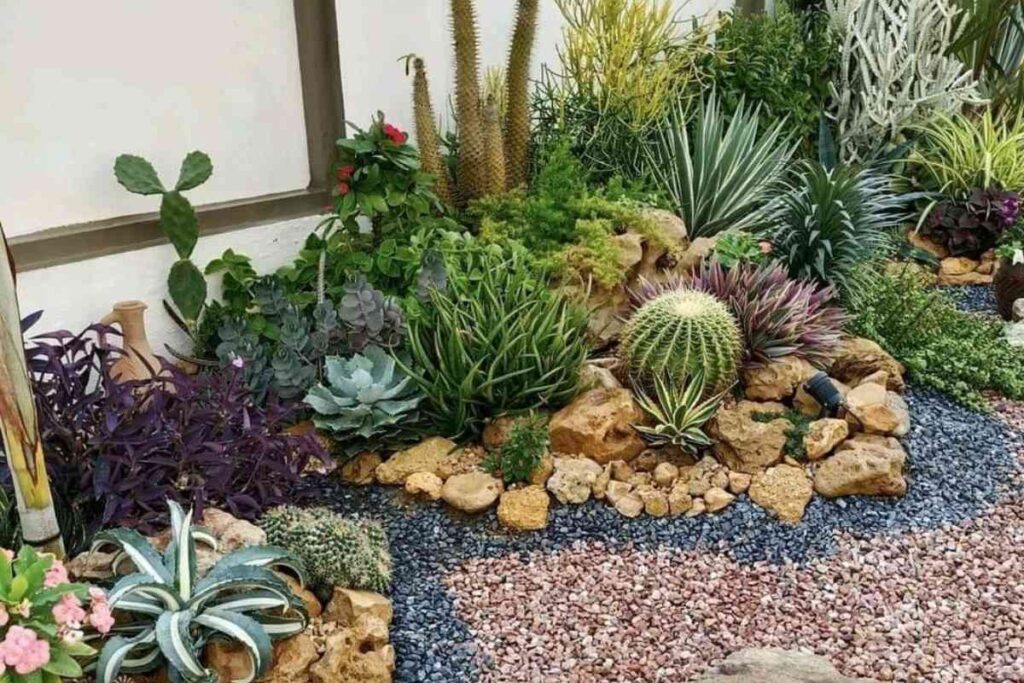
Designing a Mountainous Succulent Rock Garden in your yard with a convincing miniature landscape is one of the coolest ways to build a succulent rock garden, but it takes careful planning and consideration of scale.
Select a spot in your yard that receives the appropriate amount of sunlight for your succulents. Consider finding a spot with a natural slope or elevation to enhance the mountainous effect.
Collect rocks of different sizes, shapes, and colors. Larger rocks can be used to represent mountains or hills, while smaller ones can be placed to create valleys and slopes. Arrange them in a way that mimics the desired topography. I find it helpful to use a few pictures of the kind of landscape I want to build as a reference.
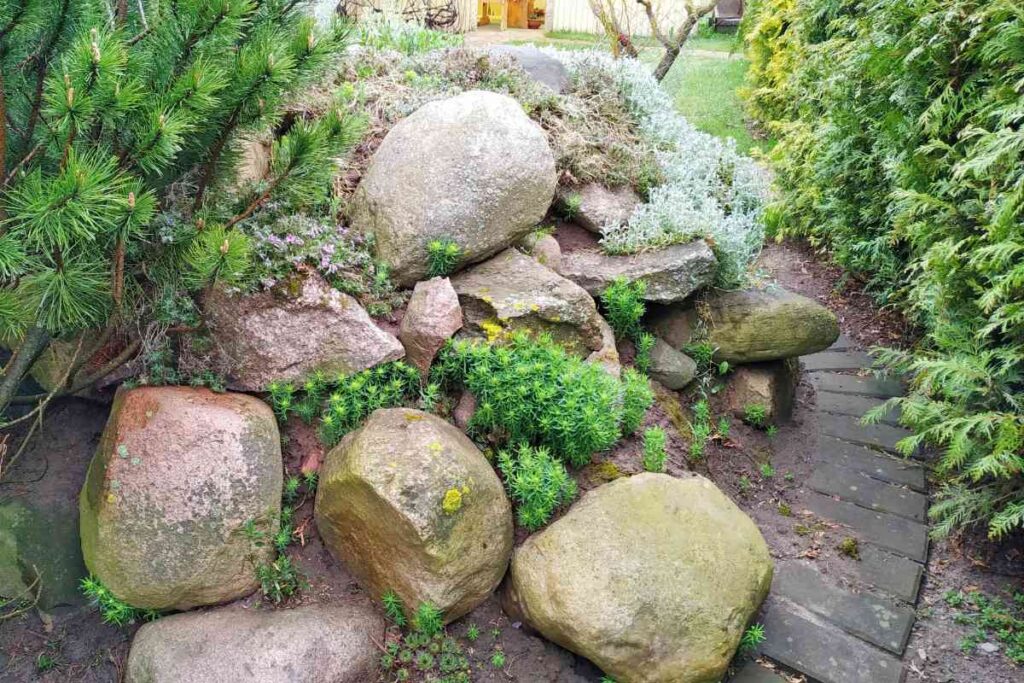
Consider the natural flow and contours of the area. Use only one kind of rock, or at most two or three different types. The more types of rock, the harder it is to create a natural look.
When you’re placing them, keep the grain and shape in mind so that the rocks look like they’re naturally pushing out from the ground.
Create a sense of depth by arranging rocks of varying sizes and heights. Position the larger rocks towards the back to give the illusion of distance.
To create a convincing miniature landscape, choose succulents that are proportional to the size of the rocks. Avoid planting succulents that will quickly outgrow the space and disrupt the overall aesthetic.
Place the succulents strategically around the mountains, hills, and valleys. Use the natural crevices and spaces between the rocks as planting areas. Select succulents with different textures, colors, and growth habits to create visual interest and mimic a diverse mountainous environment.
2. Vertical Succulent Rock Garden
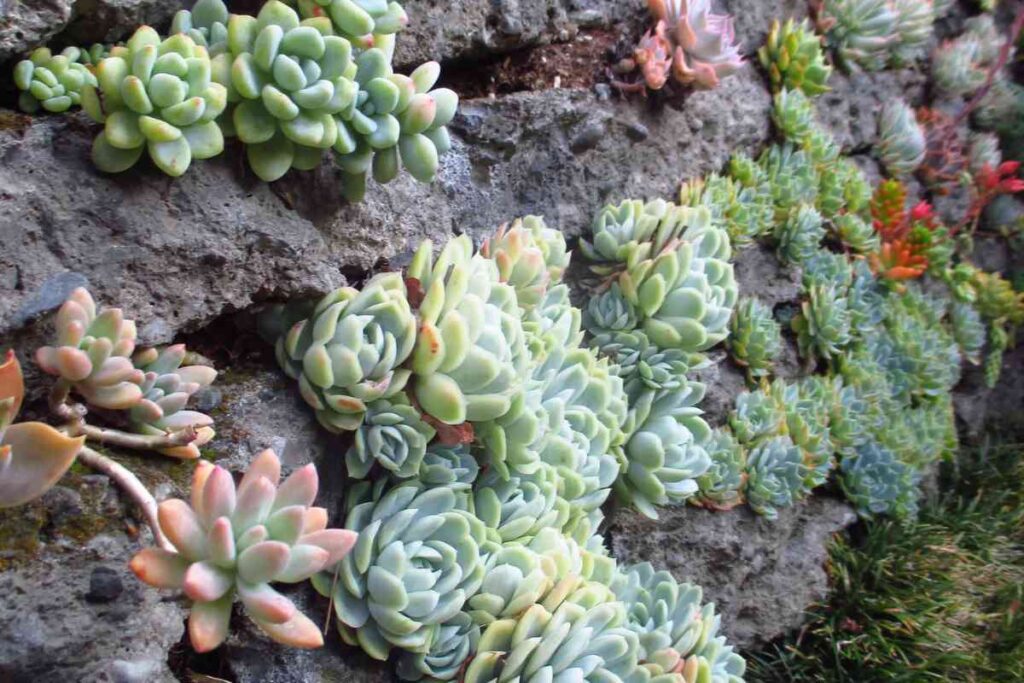
A Vertical Succulent Rock Garden is an excellent choice when you have limited space or want an interesting way to hold soil in place. It offers a practical and visually appealing solution to maximize your gardening area.
If you don’t have a natural soil slope to build against, you can build a self-standing wall with soil in pockets throughout the plant succulents. However, this is a great option if you need to hold soil in place.
Collect rocks of different sizes and shapes. Opt for rocks that are relatively flat or have crevices, as they will create pockets for planting.
If needed, you can attach a wire mesh or geotextile fabric to the area to provide stability and prevent soil erosion.
Begin by placing larger rocks at the base. These rocks will serve as a solid foundation and provide stability to the structure. Position them securely against one another
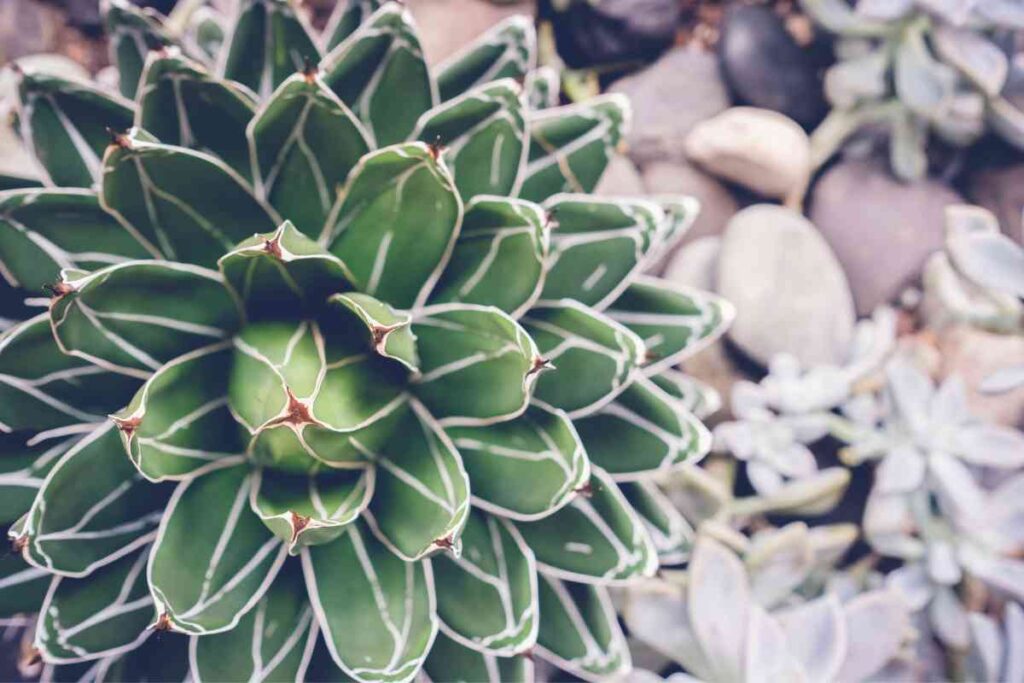
As you build upward, progressively use smaller rocks. Stack them on top of each other, leaving gaps or spaces between the rocks. The gaps will serve as planting pockets for your succulents.
Fill the spaces between the rocks with a well-draining soil mix suitable for succulents. A blend of potting soil, sand, and perlite or pumice works well. Ensure each planting pocket has enough depth to accommodate the roots of the succulent plants.
Carefully insert the root balls of your succulent plants into the planting pockets. Use tiny baby succulents to get into every crevice. Gently pack the soil around the roots to secure the plants in place. Consider the growth habits and spacing requirements of the succulents to achieve a balanced and visually pleasing arrangement.
3. Miniature Succulent Rock Garden
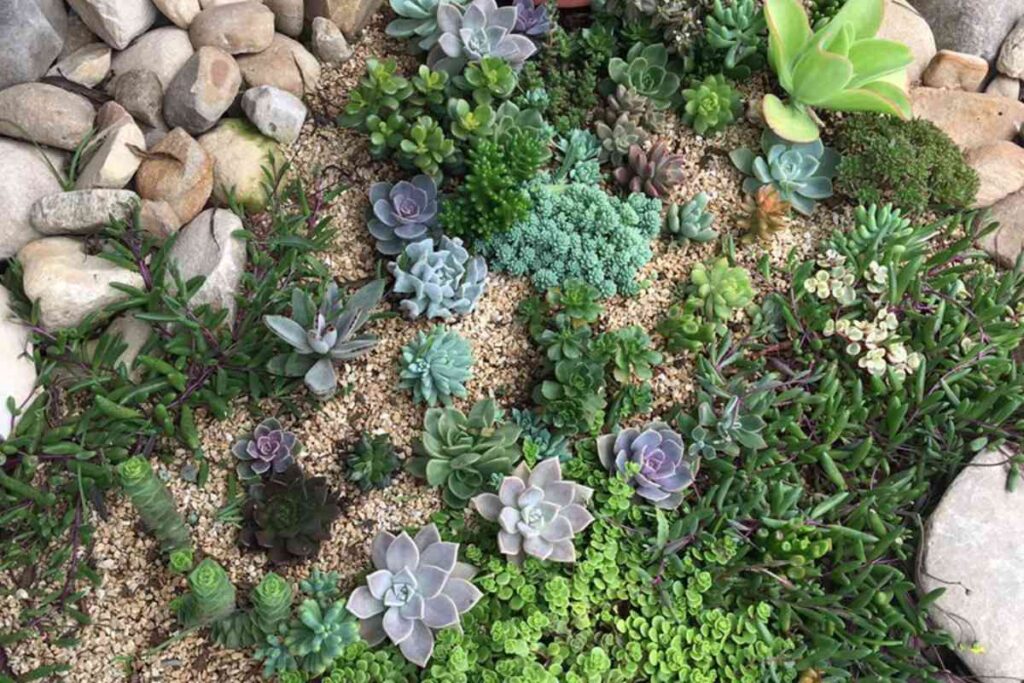
Succulents work great as tiny arrangements, and the mini succulent rock garden is no exception. Whether you want to use a container or plant it in the ground, this is a great way to create a bright spot of beautiful succulents affordably and easily.
Collect rocks of the same type with varying shapes and sizes. Look for rocks with natural textures and interesting grains.
Visualize the landscape you want to create. Unlike in a larger rock garden, you have the opportunity to move rocks around easily, so take advantage of that.
Consider the positioning and arrangement of rocks to form a natural-looking terrain. Place larger rocks at the back or towards the center, gradually transitioning to smaller rocks at the front or edges.
Use your fingers or a small garden trowel to create pockets or depressions in the soil between the rocks. These pockets will serve as planting areas for the succulents. Vary the depth and size of the pockets to accommodate different succulent species and create a sense of depth.
Choose succulents that naturally stay small or have slow growth habits. Look for compact varieties, miniature species, or those labeled as “dwarf” or “mini” in their names. Here are some good options to choose from:
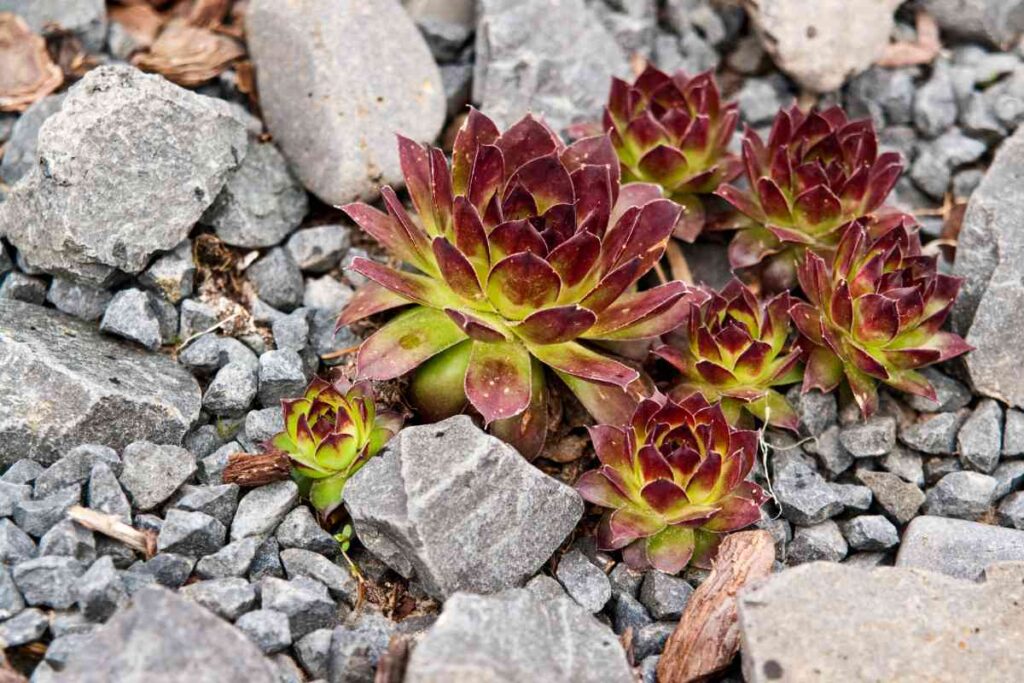
- Haworthia cooperi: Haworthia cooperi is a small succulent with rosette-shaped, translucent leaves that are often described as resembling tiny pearls or windows. It has a compact growth habit and stays relatively small, making it ideal for miniature gardens. It thrives in bright, indirect light. Haworthia cooperi can be used as a perfect groundcover in a miniature succulent garden.
- Echeveria ‘Lola’: Echeveria ‘Lola’ is a stunning hybrid succulent known for its rosettes of pastel pink to lavender leaves with a hint of blue. The leaves have a powdery, slightly waxy texture, and their coloration intensifies with sunlight exposure. ‘Lola’ has a compact growth habit and produces offsets, forming beautiful clusters over time. This succulent can be used as a focal point in a miniature succulent garden, as its unique color and form create an eye-catching display. It thrives in bright light.
- Sedum pachyphyllum: Sedum pachyphyllum, also known as Jelly Bean or Stonecrop, is a small, low-growing succulent with plump, cylindrical leaves that resemble jelly beans. The leaves are green with a hint of pink or red along the edges. Sedum pachyphyllum is a hardy succulent that can tolerate neglect and is perfect for a miniature garden. Its trailing growth habit makes it suitable for cascading over the edges of containers or rock walls. It prefers bright light and well-draining soil.
- Graptopetalum: Graptopetalum is a genus of succulents that includes various species with rosette-shaped, fleshy leaves. These plants come in different colors, including shades of green, pink, purple, and gray. Graptopetalum succulents are often prized for their delicate, stacked leaf arrangement and their ability to produce offsets, forming beautiful clumps. They can be used to add texture and variety to a miniature succulent garden.
- Graptosedum: Graptosedum is a hybrid succulent that combines the characteristics of Graptopetalum and Sedum. These plants typically have rosettes with fleshy leaves that come in various colors, including shades of green, pink, and purple. Graptosedum succulents are easy to grow and propagate, making them great for a miniature garden. They can be used to create colorful clusters or as groundcover in between larger succulents. Graptosedum thrives in bright light and well-draining soil.
Prioritize weed control in your miniature succulent rock garden. Weeds can quickly upset the miniature look and smother succulents. Apply a layer of gravel between the plants and rocks to discourage weed growth.
Trim or prune the succulents as needed to maintain their small size and desired shape.
Here are even more ideas for making a mini succulent garden.
4. Desert Valley Succulent Rock Garden
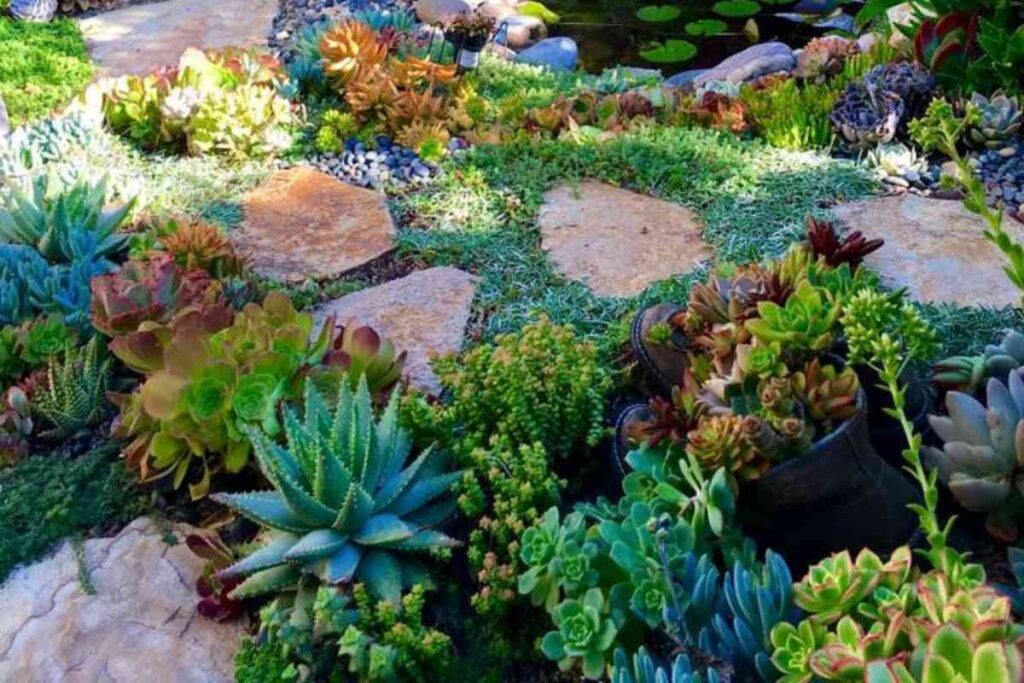
Want to fill up some space with your succulent rock garden? A Desert Valley Succulent Rock Garden is perfect. A trail of stepping stones leads you through a garden with a variety of colors and textures, blooming with flowers
Begin by evaluating the area where you want to create the rock garden. Take note of the sunlight exposure, soil type, drainage conditions, and any existing plants or structures that may impact the design.
Plan a meandering path using stepping stones, allowing visitors to navigate through the garden and admire the succulents and rocks. Choose a material for the stones that complements your decorative stone choices for the garden.
With a large garden like this, you can get away with more of a variety of rocks in different sizes, shapes, and colors. Use larger rocks to create focal points and add smaller ones clustered around them and scatterd out to add depth to the garden.
Arrange them strategically, placing the bigger ones further from the path and gradually transitioning to smaller rocks as you approach the path. Make sure to match grain and shape to make them appear natural.
Select a diverse range of succulents to introduce variety in color, flowers, and textures. Consider succulents like Agave, Aloe, Echeveria, Sedum, Sempervivum, and Crassula. Take into account their growth habits, colors, and flowering seasons when deciding their placement in the garden.
After planting the succulents and placing the major stones, fill the gaps between them with smaller rocks, gravel, or decorative pebbles to prevent weed growth and complement the overall look.
5. Dry Stream Succulent Rock Garden
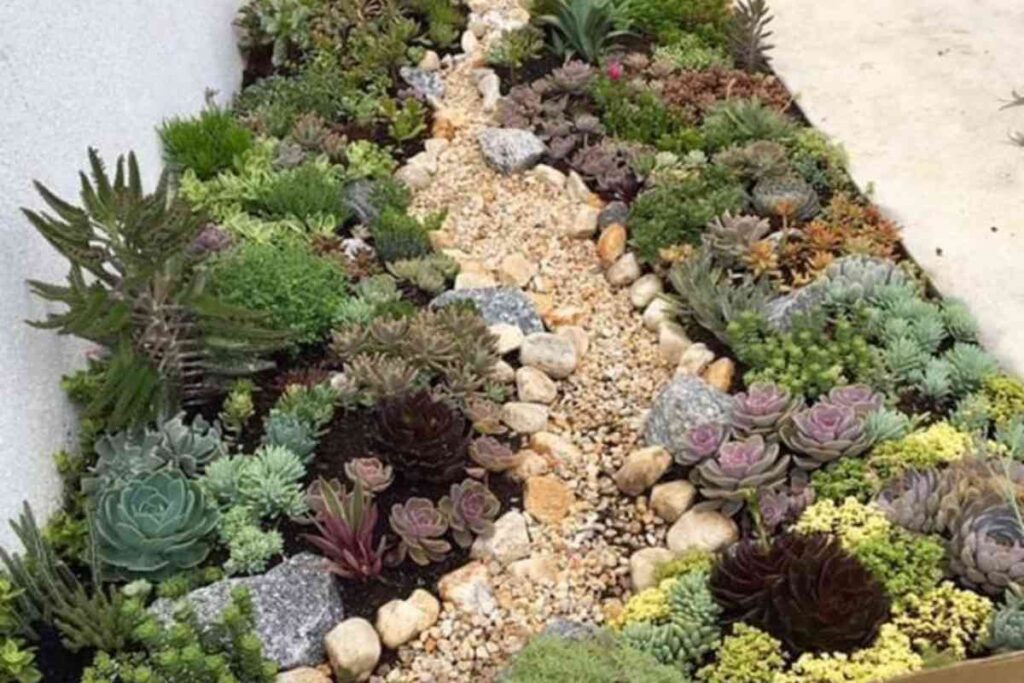
By using gravel to replicate the look of a stream and incorporating rocks and succulents, you can create a beautiful and low-maintenance garden that has a natural appeal.
This style works well next to paths or in awkward spots near the house that otherwise are hard to garden in. Anywhere with a long stretch of narrow space is perfect.
Determine the size and shape of the dry stream garden. I like to sketch out the desired path of the stream and the arrangement of rocks and succulents, incorporating curves and varying widths to make it look more natural.
It can be trickier than you’d expect to make a stream shape that looks natural, so I do it on paper first.
Next, I like to use a rope or hose to outline the path of the dry stream on the ground and adjust the placement until I’m satisfied with the shape and “flow”.
Dig out the soil within the marked area to create a shallow depression for the dry stream. The depth can vary depending on your preferences, but aim for a depth of around 2-4 inches (5-10 cm). If you’re using it to drain excess water from a gutter, you may want to go deeper.
If you’re using the stream for drainage, you may want to line the excavated area with landscape fabric. This will help prevent weed growth, ensure better drainage, and prevent the soil around the succulents from getting waterlogged.
Fill the excavated area with gravel to replicate the look of a streambed. Choose gravel in colors that complement your overall design and landscape. Smooth river rocks or pea gravel work well for this purpose. Spread the gravel evenly along the stream path, ensuring it is level and compacted.
Select a variety of rocks in different sizes and shapes to create interest and mimic the appearance of a natural stream. Start by placing larger rocks strategically along the streambed, focusing on creating focal points and varying elevations. Gradually add smaller rocks around the larger ones, ensuring they fit naturally within the design.
Consider using low-growing succulents, such as Sedum, Sempervivum, and Echeveria, to resemble plants growing near a stream. Plant them among the rocks and gravel, just outside of the stream leaving enough space for growth.
To enhance the visual appeal, consider adding additional elements such as driftwood or drought-tolerant grasses along with the succulents.
6. Rock and Container Succulent Garden

Designing a rock and container succulent garden using terra cotta pots and rocks allows you to have better control over the soil conditions while creating an appealing multi-level design. It offers flexibility, enhances the visual interest of the garden, and provides an opportunity to grow a variety of succulents in a limited space.
Choose a variety of terra cotta pots in different sizes and shapes to add visual appeal to the garden. Make sure the pots have plenty of drainage holes. Terra cotta is best for this design because it’s affordable, best for succulents, and offers a consistent look. However, you can experiment with ceramic or concrete too.
Decide on the arrangement of the rocks and containers, keeping in mind the desired aesthetic and functionality. It’s best to arrange them BEFORE they’re full of succulents if possible. Consider creating different levels or tiers using rocks to add depth and interest to the design.
Most succulents are suitable for container gardening. Consider different sizes, colors, and textures to add variety to the garden. Place taller containers towards the back or center to create height and depth.
Group smaller pots together for a visually pleasing arrangement. Ensure the containers are stable and well-balanced.
It’s visually interesting to fill some pots with one kind of succulent, and have other as mixed succulent arrangements.
Apply a layer of gravel or pebbles around the base of the pots to prevent weed growth.

General Tips for Planting a Succulent Rock Garden
- Soil: Succulents thrive in well-draining soil, so it’s crucial to use a suitable succulent or cactus potting mix. This type of soil provides good drainage and prevents excess moisture around the roots. If you’re planting directly in the ground, amend the existing soil with materials like perlite or coarse sand to improve drainage.
- Light: Most succulents require bright light to thrive. Choose a location for your rock garden that receives ample sunlight, preferably at least 6 hours of direct sunlight per day. However, be mindful of intense afternoon sun in hot climates, as it can scorch the leaves of some succulent varieties. If necessary, provide some shade or filtered light during the hottest part of the day.
- Drainage: Succulents are highly susceptible to root rot if their roots sit in waterlogged soil. Ensure that your planting area or containers have excellent drainage.
- Rocks and Stability: When incorporating rocks into your succulent garden, prioritize stability. Use rocks that are solid, durable, and able to withstand the weather conditions in your area. Arrange them securely, ensuring they won’t shift or pose a hazard. Place larger rocks first to anchor the design and then add smaller rocks around them. Pay attention to weight distribution, especially when building taller rock structures, to prevent potential accidents.
- Safety: Exercise caution when working with rocks, especially if they are very heavy or have sharp edges. Wear appropriate protective gear, such as gloves and closed-toe shoes, when handling and placing rocks to prevent injuries. Enlist the help of others if needed, particularly for larger rocks or complex installations.
- Plant Spacing: Provide enough space between succulents to allow for healthy growth and prevent overcrowding. Proper spacing ensures adequate airflow and minimizes the risk of diseases and pest infestations. As a general guideline, leave a few inches of space between each plant, considering the mature size of the succulents.
- Watering: Succulents have low water needs and are adapted to arid conditions. Avoid overwatering, as it can lead to root rot and other issues. Water the plants thoroughly but infrequently, allowing the soil to dry out between watering sessions. Succulents are generally more tolerant of underwatering than overwatering.
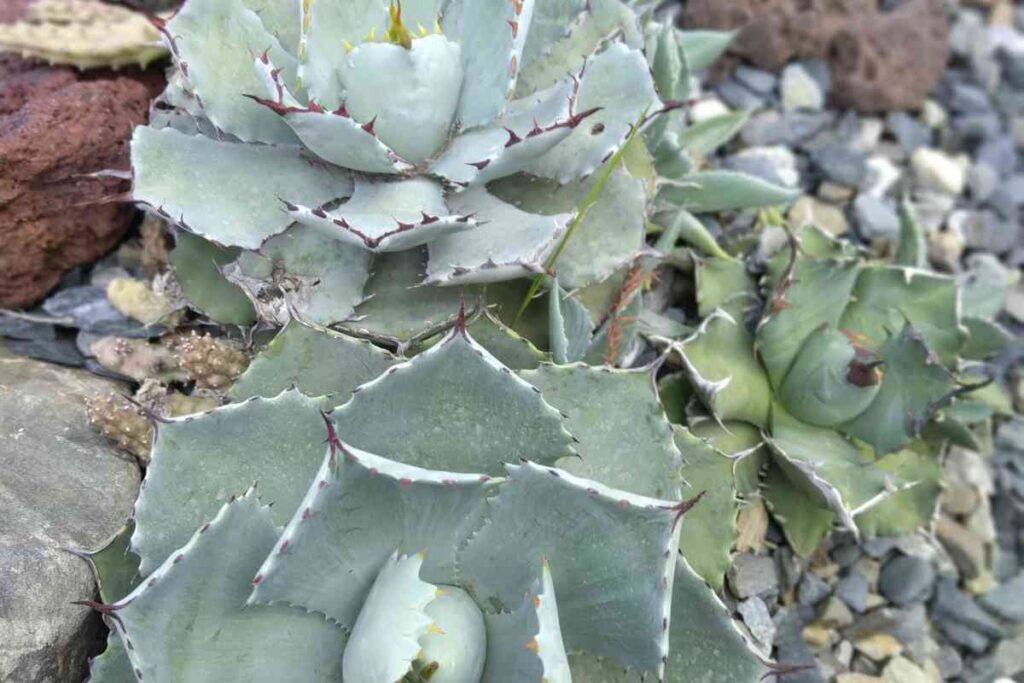
Conclusion
No matter what your garden is like, at least one of the succulent rock garden ideas on this list is sure to work for you. Rocks and succulents go naturally together, so it isn’t hard to make a gorgeous display using them. Have fun!
Want more than rocks in your succulent display? How about making a succulent fairy garden? Worried about your succulents’ overall health? Here’s everything you need to know to take great care of your succulents.

